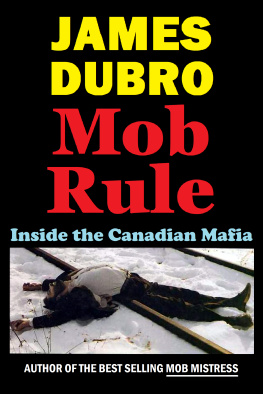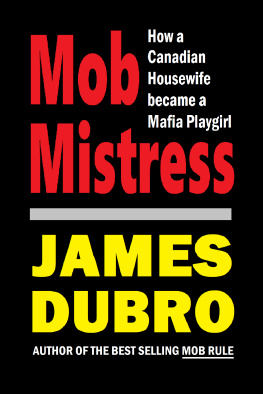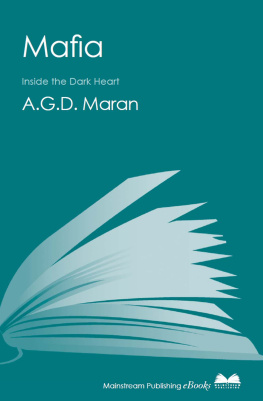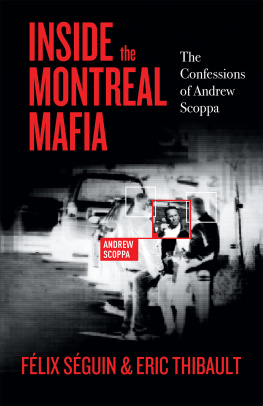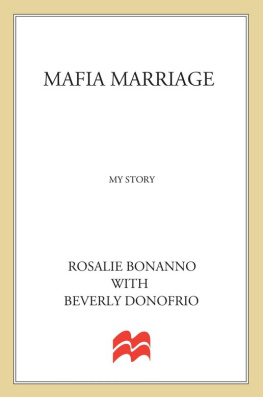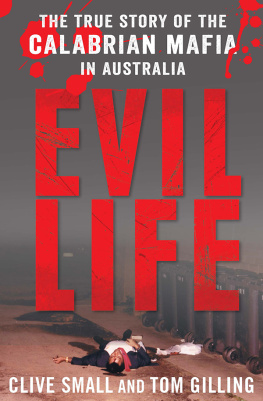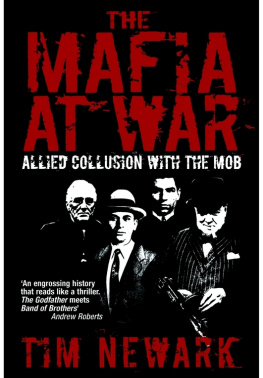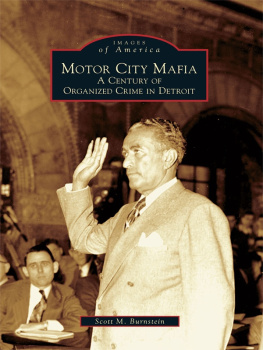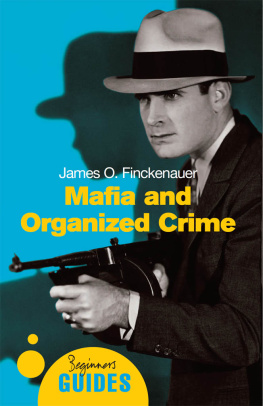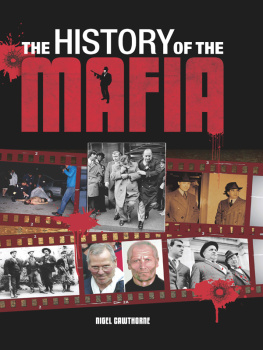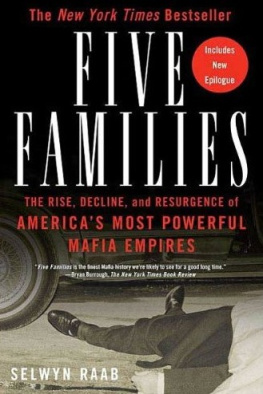Preface (1985)
IN THE LAST YEAR there has been a lot of media coverage of the Italian governments crackdown against the Mafia under Italys new tough anti-Mafia laws. Pope John Paul II himself has in no uncertain terms condemned the Mafia by name and condemned as well its concept of omert, the Mafia code of total silence that forbids its members to talk to outsiders. Omert is ruthlessly enforced, and a member who talks risks death. In the United States an all-out offensive has been launched by the FBI and federal strike forces against mob bosses, using a hitherto rarely used section of the U.S. criminal code adopted in 1970 and popularly known as the R.I.C.O. statutes (Racketeer-Influenced and Corrupt-Organization Act). R.I.C.O. allows the government to make a case against a Mafia member merely on the basis of having evidence that he belongs to an organization involved in continual criminal activity known as the Mafia and run by a commission of bosses. Five of the bosses and some of their underlings have been indicted in New York City alone.
But all this activity is on the American and international stage. Canada has no R.I.C.O. statute, and there are no anti-Mafia laws here similar to those in Italy. Yet the Mafia is alive and well, indeed it is thriving, in Canada. And it has been here since the turn of the century under one guise or another. But notwithstanding this, there are still a lot of myths about organized crime and the Mafia.
Underworld reaction to my August 1984 article in Toronto Life entitled Life Inside the Mob, which featured a portrait of the late Toronto mobster Paul Volpe on the cover, reinforced one important fact: Toronto is, has been, and always will be a mob city. Having worked on the CBCs celebrated series Connections: An Investigation into Organized Crime (a co-production of the CBC and Norfolk Productions) as its research director and associate producer for five years, from 1974 until 1979, and on other organized-crime stories as an investigative journalist for CBC Televisions flagship current affairs program, the fifth estate, for three years (where I was responsible for the exclusive interview with hit man Cecil Kirby broadcast in 1984 as well as other organized-crime stories, including one on Chinese gangs in Canada), I was more than familiar with the scope of mob activities in Canada. Still, I was staggered by the number of organized-crime members and their associates (known as rounders in the street world, because they hang around mobsters) who came out of the woodwork to comment directly or indirectly on my Toronto Life article. Not that the mob itself likes publicity, but rounders, mob associates, and mob groupies, of which there are thousands in the Toronto area alone, like to feel part of the action, and my article on the mob was the first bit of non-sensationalistic reporting the underworld has had for some time. I was struck by the many congratulatory calls from mob circles, and their frequent insistence that they be allowed to correct or add the most minute details to the retelling of old mob stories. One reason for this outpouring from organized crime itself is that in the article I struck a chord that has not been articulated for some time: namely, how the mob really works.
People inside the mob world were tired of the Hollywood cliches of The Godfather and the oversimplifications in the media (especially television), which depict all organized crime as being controlled by an all-powerful Mafia. As insiders know, this is not how organized crime works in the 1980s, especially in the major metropolitan areas such as Toronto. Displacing this mythic view with the hard reality of a fractured, highly factionalized multicultural mob operating in Ontario was so unusual that the mob responded in kind by contacting me.
If this book serves one purpose, it is to present the facts about organized crime in North America as they are, not as they were or as some people, including many of those in the media, would like them to be. The cliches of cheap fiction have somehow permeated most of the coverage of organized crime in our society, at least the coverage that anyone is paying attention to.
The focus of this book is the criminal career of Paul Volpe, from the early 1960s until his murder in late 1983. Volpe is the archetypal Canadian mobster of the period, and a major part of this book deals with how, why, and with whom he operated. There is also an attempt to recapture some of the lost history of organized crime in Canada, going back to the extortions of the Black Hand in the first decade of the twentieth century, long overlooked by other journalists in the crime area. The rest of the book delineates the deadly struggle in Canada between the old mob, represented by Toronto-born criminals such as Volpe, and the new mob of tougher, leaner, Italian-born mobsters like Remo and Cosimo Commisso and Domenic Racco, who have been moving in on the older group in a fight for territory and mob supremacy. There is also a look at certain interesting mob characters, and suggestions of what might be done by society to curb the power and activities of the mob. Ontario is emphasized over Quebec and British Columbia (though Quebec and Vancouver mob characters invariably come into the picture as they relate to the situation in the rest of Canada), as there have already been several books on aspects of organized crime in Quebec as well as the highly publicized Quebec Crime Probe reports of the seventies. Amazingly, this is the first serious book-length study dealing primarily with the mob in Canada outside Quebec, but this book is by no means the final word on the subject of the Mafia in Canada.
Furthermore, this book is not an attempt to glamorize criminal life or exaggerate the importance and influence of gangsters. The simple fact is that the most colourful characters of the underworld are Damon Runyonesque individuals with a natural intelligence, imagination, and sense of humour, and possessed of an earthy street wit that takes many in. However, one should not be deceived by this. The worst in the underworld have no respect for human life and order murders and savage beatings as casually as others order a pizza. There are elements of the best and the worst of the underworld in Paul Volpe and his associates.
In compiling the research for this book it has been essential for me to protect the identities of several people inside the mob world (members, associates, spouses, and relatives) whose information I have good reason to believe is accurate. Every attempt has been made to verify details from mob informers, and information has been included in this account only if its source has a long track record of reliability, or I have been able to check out the data through other sources. Wherever possible I will try to indicate the nature of the source, if not the actual name. Without the assistance of these courageous informers, this book would not have been possible.
Parts of certain chapters appeared in other forms in Toronto Life and Hamilton This Month, and I thank these publications for permission to reprint this material. I also acknowledge with gratitude Norfolk Productions for kind permission to use some Connections research material and to reprint transcripts of certain interviews.
There are many people I must thank who helped me in some way in preparing this book:
Peter Herrndorf, Marq de Villiers, and Stephen Trumper, the publisher and editors of Toronto Life, for their encouragement.
Ron Haggart, Robin Taylor, Gordon Stewart, and the fifth estate, for bearing with me.
Peter Moon in Ontario and Michel Auger in Quebec for all they have so intelligently written on the subject over the past two decades.
Rick Archbold, for invaluable advice at the initial stages of the book.
My sister, Beverly Lacey, my brother, Dan, and my aunt, Rita Lyons, who have all helped in countless ways over the years.

